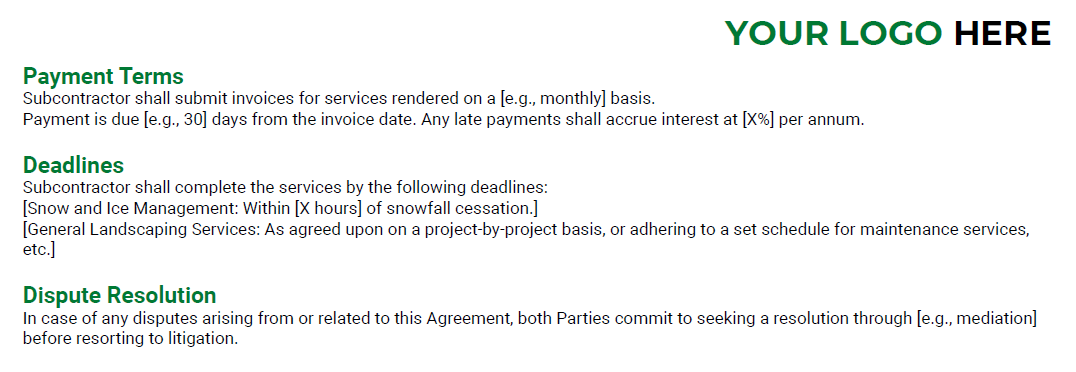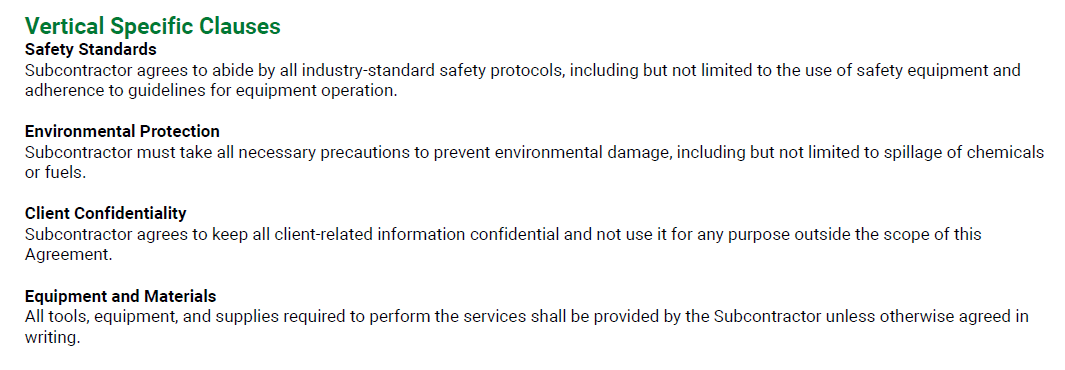Table of Contents
Table of Contents
- What are the benefits of subcontractor agreements?
- What are the key components of a landscaping subcontractor agreement?
- What are the legal considerations when drafting a landscaping subcontractor agreement?
- How to determine the duration of a landscaping subcontractor agreement
- Common mistakes to avoid when drafting a landscaping subcontractor agreement
- Better than a template: Landscaping business software
Using subcontractors helps landscaping companies to scale, overcome labor shortages, and meet demand during peak season.
Business owners can stay profitable no matter the season or challenges by working with subcontractors, whether for lawn care maintenance contracts or, most commonly, for snow and ice removal during the winter.
Protect your investments and brand reputation by using a landscaping subcontractor agreement.
If you don’t use a subcontractor agreement or haven’t visited yours in a while, it may be time to brush up on the basics. Read on to learn about the benefits and legal considerations of landscape subcontractor agreements.
>> Ready to jump right in? Download Aspire's free landscaping subcontractor agreement template here.
What are the benefits of subcontractor agreements?
Just as a landscape contract clarifies the relationship between a landscaper and their customer, a subcontractor agreement is a legal contract between a landscape business and a third-party subcontractor. Whether for a specific project or an entire agreement, it outlines:
Terms
Responsibilities
Scope of work
The benefits of a subcontractor agreement include:
Clarifies the duties, payment terms, timelines, and liabilities between the primary contractor and subcontractor, ensuring smooth project execution
Mitigates legal and financial risks associated with hiring and using subcontractors
Ensures subcontractors deliver quality landscaping services while adhering to project specifications and industry standards
Controls project costs by eliminating unexpected expenses related to subcontractor performance or disputes
Helps meet project deadlines by ensuring subcontractors complete tasks on time
Imagine you hire independent contractors for snow and ice removal. You offer your customers a service guarantee that your company will remove snow accumulations of 1 inch or greater within 12 hours. If you don’t specify those guidelines in your subcontractor agreement, your subs may consider 1 inch a dusting and only service homes after 2 inches of snow has fallen. That potentially damages your company’s trust with its loyal customers.
What are the key components of a landscaping subcontractor agreement?

Create a comprehensive landscaping subcontractor agreement by including the following sections:
Scope of work: Outlines the specific tasks and responsibilities the subcontractor must perform. It details the services to be rendered, such as shoveling, roof raking, and salting the sidewalks.
Performance standards: Ensures high-quality performance by detailing quality and safety standard expectations.
Deadlines: Details the project timeline. For a large landscaping project, this may include milestones and an overall deadline. The snow removal example would include the required response time post-snowfall.
Payment terms: Outlines the agreed-upon compensation for the subcontractor's services, including payment schedule, additional costs for extra services or materials, and invoicing and billing terms.

Dispute resolution and termination procedures: Provides a framework for resolving disputes between the contractor and subcontractor, including steps for mediation, arbitration, or other methods of conflict resolution.
This section also includes the conditions under which either party can terminate the agreement, specifying written notice periods, reasons for termination, and any associated penalties or liabilities.
Insurance requirements: Lists the insurance coverage the subcontractor must maintain, including types of insurance (such as general liability insurance, workers' compensation, or professional liability), minimum coverage amounts, and indemnification clauses.
Ask for a certificate of insurance to ensure coverage in case of injury on the job site or property damage.
What are the legal considerations when drafting a landscaping subcontractor agreement?
When drafting a landscaping subcontractor agreement, ensure compliance with applicable state laws, local regulations, and licensing requirements.
This may encompass some sections outlined above, such as insurance requirements, dispute resolution, and termination procedures.
Before signing and dating a subcontractor agreement, ensure it’s legally sound and protects all parties involved. To do so, hire a legal professional with experience in contract law to review the documents.
How to determine the duration of a landscaping subcontractor agreement
The following considerations can help you decide on the duration of an agreement with your subcontractors:
Project scope: For single-project contracts, the duration depends on the scope of the work. Consider whether the contractor is needed for only a phase of the project or the entire project timeline.
Seasonal demand: Some companies only hire subcontractors during their busiest months. Look at your historical job data to determine that duration.
Weather conditions: Agreements for specific tasks may be weather-dependent, such as snow and ice removal in winter or planting projects during the 100 Days of Hell.
The work of a landscaper can be unpredictable due to:
Weather events
Material delays
Permitting requirements
Incorporate flexibility, extension, or renewal provisions within your subcontractor agreement to allow for required adaptations. This allows both parties to review and renew the agreement if necessary.
Common mistakes to avoid when drafting a landscaping subcontractor agreement

If drafted correctly, subcontractor landscaping agreements set the stage for a valuable business relationship. However, agreement mistakes may lead to unclear expectations, shoddy work, and a tarnished reputation.
Avoid the following mistakes when drafting a landscaping contract:
Unclear scope of work: Failing to precisely outline the subcontractor's landscaping work responsibilities and tasks may result in misunderstandings, delays, or disputes over deliverables and expectations. Be sure to include all service tasks, including landscape design, mulch installation, mowing, irrigation system or sprinkler installation, and any additional services.
Vague duration and renewal terms: Ambiguity regarding the agreement's duration, renewal options, or termination clauses can lead to uncertainty, making it challenging to finish projects on deadline or plan future projects or extensions effectively.
Lack of legal review: Skipping legal review may expose both parties to risk, liability, and steep attorney’s fees.
Inadequate performance review standards: Lack of clearly defined performance standards, milestones, or evaluation mechanisms can hinder monitoring progress, work quality, and timely completion.
Better than a template: Landscaping business software
While a subcontractor agreement template provides a great starting point for hiring and managing subcontractors, Aspire is an end-to-end business management system for landscaping contractors that grants visibility into every aspect of their operations.
With Aspire, landscape business owners have the data to make informed business decisions around:
Project timelines
Budgets
Scheduling
The subcontractor portal tracks hours for subcontractors and transfers the information directly to invoices and purchasing for more accurate job costing and payroll.
PropertyIntel, part of the Aspire family of software solutions, empowers companies to take precise property measurements, create sitemaps, and perform takeoffs from anywhere.
A company could create a map of a property owner’s parking lot and sidewalk to estimate labor hours for a snow-removal subcontractor. The data syncs directly to Aspire, so crew leaders can more quickly assign tasks and arm subcontractors with valuable information.
Aspire helps manage subcontractors and provides a top-down view of the overall business for enhanced efficiency and profitability.
Book a free demo today.











